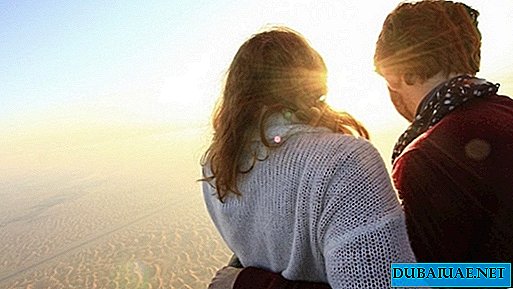Black with gold tan marks of Soga, the nickname of which can be translated as a "golden decoration", a bird flew after us from an air-conditioned room to an open training ground. We stopped, examining the barriers, training utensils, paths, and the dog danced in the sand, faithfully looking into the eyes of the owner. Running on the sand is one thing, standing on it in the heat is a completely different matter: it was May noon, the air temperature rose to 40 degrees, the top layer of sand heated up even more, degrees to 60.
The dog could not stand for a long time. She, like a ballerina, gracefully fingered with long legs and looked at Hamad, trying to determine his intentions. An understanding was read in dark-brown eyes that her "god" was talking about her. This went on for a minute. Taking advantage of the moment when we turned our attention to the minister, who poured water over the sand to compact it, she ran into the shade of the canopy on the soil protected from the sun. The edge of the paws with wool did not save from the heat.
Now the dog was watching us from its shady shelter. According to her intense attention, it was clear that the saluki "reads" the owner's face. She admits herself to be a naughty girl and is ready to break loose at the mere movement of his lips. When looking at her from afar, it seemed to us that, together with a strip of earth between the front and hind legs, parallel to the line of her body from the withers to the tail, the outlines of the dog make up a square, the vertical edges of which are slightly more horizontal. Her legs are about 65 centimeters long, so her head is at the table level. Flattened on the run with a tail upwind and an elongated neck, with ears pressed, saluki seems long and down to earth. In a calm stance, she is very tall and, thanks to her leanness, looks almost weightless. Soga is the favorite of Hamad al-Ghanem.
The native home of the Arabian saluki
In the reception room of the Center for Arab Saluki in his suburb of Abu Dhabi, near the capital's international airport, dogs are always welcome guests, they are "on duty" here. "So as not to wean from the people," - says the owner. When we arrived, "on duty" was a dog of golden color, nicknamed Jaryan (Arabic. "Running"). He met us very friendly. It was unusual that an unfamiliar dog at home did not threaten to bark, refuting the saying that "every dog is a lion in its street." Saluki generally bark a little. True, Jaryan did not rush to cuddle either.

Hamad, entering his office after us, immediately called Soga. She caressed the owner, met us and climbed into the "duty" chair. Both dogs dangled long legs from their seats and calmed down, as if they were eavesdropping on a conversation. The host was the center of attention. In some episodes, the behavior of dogs was better than the actions of people who allowed themselves to provoke them. They were invited to take sweets from the table - they were not tempted. When we moved to the small dining room, the dogs stopped at the entrance to the room. Hamad persistently invited them to enter. They did not move and did not cross the threshold, although they were noticeably nervous because of the conflicting feelings that gripped them.
According to Hamad, saluki in their behavior are closer to a cat than to a dog. They are affectionate, independent and do only what they like. Their mental abilities are very high. Characterized by understanding, they are easily amenable to training.

Hamad is the owner of the only "Middle East Saluki Center" in the Middle East. A retired officer says he opened his establishment in the interest of preserving the national heritage, one of which, along with the Arabian horses, camels and falcons, is the saluki. He is slender and fit, with a smooth face and hair, black as pepper, in which there is no gray salt yet, and speaks fluent English.
The center, created in 2001 and began to work in 2002, is its private enterprise. Several dozen Arab dogs live in it. All of them are “visiting”. Each has a passport. Microchips are fixed on the ears.
Hamad showed us separate 16-meter clean rooms with a window, a water tap, a place to rest and feed the puppies in which the "newlyweds" and already married couples have lived. Puppies live with their parents usually 3-4 months. Then they part forever.
In addition to this center, Hamad has several kennels in the country, in which at the end of last year there were more than one and a half thousand dogs. “If you want, I'll give a puppy,” Hamad suggested. Naturally, we refused a generous offer, frightened by the prospect of catching a wondrous, gentle dog in the Russian homeland. The dog breeder gives part of the offspring, sells the same part and keeps one or two dogs for himself. Customers prefer sand-colored dogs, but love everyone. In principle, any suit is acceptable for them, if only they would like a thin-legged and frisky baby. The puppy is priced over $ 1,000. Hamad carefully selects mating pairs to maintain breed quality. It uses females for offspring no more than three times, so that offspring do not fade. The composition of the marriage families changes.

In Abu Dhabi and Dubai, you can see different thoroughbred dogs, which the multinational local "Babylon" imported from around the world. But saluki in the streets are almost impossible to meet. They live in the palaces and villas of the sheikhs. Dogs, including those born in the local center, are, according to the emirate canine, in all the noble local families. They give him patronage and support in the spirit of the Eastern tradition to favor with the grace, gold or a bathrobe from the royal shoulder of poets, artists and especially proven subjects.
Breeding saluki is royal fun. Hamad often goes hunting with the Arabian nobility, which is usually conducted from September to January. He has been on hunting trips in Pakistan and other countries with the UAE founder, late President Sheikh Zayed, hunting with the King of Bahrain. With local sheikhs, accompanied by dogs, traveled to Uzbekistan and Kazakhstan.
Dog is a friend of man
The dog was the first animal that a man tamed. It is believed that this happened 20,000 years ago in the Asian region. In Europe, it appeared only in the 6th century BC. There are allegations that the first to use dogs for hunting was one of the Persian kings. Domestic dogs were already among the Sumerians. Excavations carried out on Iraqi territory, where the Sumerian empire flourished in 7-6 millennia BC, indicate that representatives of this earliest civilization on earth used the services of dogs similar to saluki. Among the finds there are seals and engravings depicting a dog, which indicate that she was one of the first domesticated animals.
In later times, in ancient Egypt, a dog of the same shape as the saluki took a place of honor. Her position was incomparably higher than that of other pets. They called it "El Khor" (Arabic. "Noble"). Drawings of the "friend of man" with fluffy ears, tail and paws can be found in burials dating back to the 3rd millennium BC. There are images of the pharaoh Tutenhamun accompanied by dogs, scenes of hunting for ostriches with their participation.
Saluki were the favorite dogs of the Egyptians and gained fame as "royal dogs." The ancient Egyptians adored them, worshiped them, and if any of them died, declared mourning, shaved their eyebrows, wailed and beat in gongs. Dogs were mummified with no less care than the bodies of the pharaohs. They were buried with collars decorated with ornaments, on which even nicknames were indicated.
Hamad says the name Saluki comes from the ancient southern Yemeni settlement of Salyuk or Salyukiya, located north of Aden. She was known to the Arabs of this region 7-8 thousand years ago. Hamad suggests that the local hunting dog is a cross between an Arabian fox and a wolf or jackal. The hybrid was very noble, smart and friendly. He began to live near a man, and then with him. In pre-Islamic times, Saluki accompanied all nomadic tribes on a journey. Puppies were raised in the harem halves, and adult dogs accompanied the owners. From pets only they were allowed to enter tents and palaces.
European cynologists believe that the most ancient drawings of dogs dating back to the 5th millennium BC depict saluki or, in any case, its direct ancestors. The inherent structural features of the body are characteristic of images found on ancient pottery and in Anatolian wall paintings left by a man’s hand about 6 thousand years ago. Comparing modern Arab dogs with their ancient images, experts believe that saluki is one of the least changed dog breeds in the evolutionary process.
The Arab hound can be compared with the Russian greyhound. Hamad, by the way, is familiar with the Russian analogue of the saluki and even knows the word "greyhound", which, of course, exceeds the Bedouin's favorite in size, but, according to Hamad, is inferior to her in endurance.
Saluki is characterized by incredibly sharp, just falconry vision and develops a very high speed while running - up to 65 km per hour. Arabs claim that she can catch up with the fast-moving gazelle. This is a fairly prominent dog, with short smooth hair and a dry, lean body. Saluki legs are very high, which helps her not to sink in the sand. There is a subspecies of saluki called "feathery". Its representatives have hairy ears, tail and lower legs. Both species are mixed and equally popular.
The importance of the dog’s role in Arabian society is evidenced by the attention paid to it by the prophet Muhammad, who expressed the opinion of Islam about all the fundamental situations in the life of the Arab society of his time. “Allowed are the blessings and that which you taught the predatory animals, training them like dogs that you teach what Allah taught you. Eat what they grab for you, and remember the name of Allah over it,” it says he heard divine revelations recorded in the Quranic surah “Meal”. According to legend, the prophet banned the sale of dogs in that part, which can be classified as excesses. A Muslim should not buy a dog for beauty and entertainment, since the funds used for pampering are better spent on charity.
The herald of Islam allowed hunting and shepherd dogs to trade. At the same time, he made a reservation that “the black dog is the devil,” and forbade hunting with her. I asked Hamad if he really believes in the evil features of the black suit. He looked at me as a first grader and completely killed me with an undeniable, in his opinion, argument: "You know that a black cat is a devil. It’s a dog, too." - What can I say in response? Nevertheless, he has black dogs. Although the vast majority of its packs have the color of the golden sands of the desert. Most likely, the choice of suit of dogs on the Arabian Peninsula is not dictated by religious considerations, but by natural circumstances: sand-colored dogs do not need to lurk, it is almost impossible to notice them from afar in the desert. The conditionality of the choice of the suit of saluki by natural conditions is confirmed by the presence of black dogs in the Middle East, where there are dark volcanic deserts.
Modern Islamic faiths favor saluki. Even one of the fatwas (religious precepts) of the Al-Azhar mosque is dedicated to her. Theologians of the mosque believe that "the use of dogs in the house is for the good and permissible to prevent evil." The body of the dog, its saliva and sweat are considered clean. A dog does not defile a person with its touch. Even if she touched a Muslim during prayer, her touch does not cancel the prayer, the prayer is recognized as fulfilled.
In Islam, a dog is offended by the fact that it is forbidden to eat game by it. In this regard, it stands below the falcon, which does not defile prey, even pecking it, and a Muslim can use it for food.
You can’t eat with a dog from one dish, but an exception is made from this rule, since on Arabian, desert paths this condition is difficult to observe. "But what about the nomad had to water his dogs?" Hamad asks. - "He could not carry special utensils for them!" Therefore, tradition allows the use of dishes from which the dog drank or ate, but before that, it must be washed seven times, including once with sand.

Not with bread alone ...
Continuing this topic, one can not help but talk about the dog restaurant, in which we were invited to conduct a tasting lunch at the kennel. Hamad invited us into the kitchen and introduced the chef. He, in turn, introduced the menu. It is very diverse. The only thing that dogs are not accustomed to is raw meat, apparently so that they do not indulge in caught game. It is given very rarely, twice a month in small quantities and only for entertainment. Dogs, according to Hamad, hardly eat it, preferring “restaurant” dishes. Boiled chicken is included in their daily diet. In general, all food is boiled, including peas, beans, rice, various cereals, herbs, seasonings. Some dishes are seasoned with honey. Wine vinegar is added almost always. Hamad suggested we try the dog on duty lunch. After he did this himself, we also decided. Exchanging opinions, we came to the conclusion that if we did not know that the dish was prepared for dogs, we decided that it was quite original and quite acceptable for a snack while taking an aperitif. There is no doubt that the Bedouin, who got on the edge of a monotonous milk-date diet, would be delighted with the taste of the dishes of the dog's restaurant.
In conclusion, I want to wriggle before the saluki for the words "kennel", "pack" and "dog spirit". Dogs are so good, affectionate and friendly, that when applied to them, these terms seem too offensive.
Victor Lebedev
Photo: Irina Ivanova










